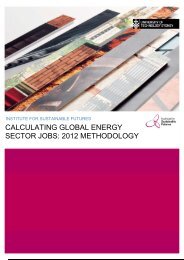download the mexico energy revolution scenario
download the mexico energy revolution scenario
download the mexico energy revolution scenario
You also want an ePaper? Increase the reach of your titles
YUMPU automatically turns print PDFs into web optimized ePapers that Google loves.
WORLD ENERGY [R]EVOLUTION<br />
A SUSTAINABLE ENERGY OUTLOOK<br />
7<br />
<strong>energy</strong> sources and security of supply | STATUS OF GLOBAL FUEL SUPPLIES<br />
Most reserves are initially understated and <strong>the</strong>n gradually revised<br />
upwards, giving an optimistic impression of growth. By contrast,<br />
Russia’s reserves, <strong>the</strong> largest in <strong>the</strong> world, are considered to have<br />
been overestimated by about 30%. Owing to geological similarities,<br />
gas follows <strong>the</strong> same depletion dynamic as oil, and thus <strong>the</strong> same<br />
discovery and production cycles. In fact, existing data for gas is of<br />
worse quality than for oil, with ambiguities arising over <strong>the</strong> amount<br />
produced, partly because flared and vented gas is not always<br />
accounted for. As opposed to published reserves, <strong>the</strong> technical ones<br />
have been almost constant since 1980 because discoveries have<br />
roughly matched production.<br />
shale gas 62<br />
Natural gas production, especially in <strong>the</strong> United States, has recently<br />
involved a growing contribution from non-conventional gas supplies<br />
such as shale gas. Conventional natural gas deposits have a welldefined<br />
geographical area, <strong>the</strong> reservoirs are porous and permeable,<br />
<strong>the</strong> gas is produced easily through a wellbore and does not<br />
generally require artificial stimulation. Non-conventional deposits,<br />
on <strong>the</strong> o<strong>the</strong>r hand, are often lower in resource concentration, more<br />
dispersed over large areas and require well stimulation or some<br />
o<strong>the</strong>r extraction or conversion technology. They are also usually<br />
more expensive to develop per unit of <strong>energy</strong>.<br />
Research and investment in non-conventional gas resources has increased<br />
significantly in recent years due to <strong>the</strong> rising price of conventional natural<br />
gas. In some areas <strong>the</strong> technologies for economic production have<br />
already been developed, in o<strong>the</strong>rs it is still at <strong>the</strong> research stage.<br />
Extracting shale gas, however, usually goes hand in hand with<br />
environmentally hazardous processes. Even so, it is expected to increase.<br />
table 7.1: overview of fossil fuel reserves and resources<br />
RESERVES, RESOURCES AND ADDITIONAL OCCURRENCES OF FOSSIL ENERGY CARRIERS ACCORDING TO DIFFERENT AUTHORS. C CONVENTIONAL (PETROLEUM<br />
WITH A CERTAIN DENSITY, FREE NATURAL GAS, PETROLEUM GAS, NC NON-CONVENTIONAL) HEAVY FUEL OIL, VERY HEAVY OILS, TAR SANDS AND OIL SHALE,<br />
GAS IN COAL SEAMS, AQUIFER GAS, NATURAL GAS IN TIGHT FORMATIONS, GAS HYDRATES). THE PRESENCE OF ADDITIONAL OCCURRENCES IS ASSUMED<br />
BASED ON GEOLOGICAL CONDITIONS, BUT THEIR POTENTIAL FOR ECONOMIC RECOVERY IS CURRENTLY VERY UNCERTAIN. IN COMPARISON: IN 1998, THE<br />
GLOBAL PRIMARY ENERGY DEMAND WAS 402EJ (UNDP ET AL., 2000).<br />
coal<br />
Coal was <strong>the</strong> world’s largest source of primary <strong>energy</strong> until it was<br />
overtaken by oil in <strong>the</strong> 1960s. Today, coal supplies almost one<br />
quarter of <strong>the</strong> world’s <strong>energy</strong>. Despite being <strong>the</strong> most abundant of<br />
fossil fuels, coal’s development is currently threatened by<br />
environmental concerns; hence its future will unfold in <strong>the</strong> context<br />
of both <strong>energy</strong> security and global warming.<br />
Coal is abundant and more equally distributed throughout <strong>the</strong> world<br />
than oil and gas. Global recoverable reserves are <strong>the</strong> largest of all<br />
fossil fuels, and most countries have at least some. Moreover, existing<br />
and prospective big <strong>energy</strong> consumers like <strong>the</strong> US, China and India<br />
are self-sufficient in coal and will be for <strong>the</strong> foreseeable future. Coal<br />
has been exploited on a large scale for two centuries, so both <strong>the</strong><br />
product and <strong>the</strong> available resources are well known; no substantial<br />
new deposits are expected to be discovered. Extrapolating <strong>the</strong><br />
demand forecast forward, <strong>the</strong> world will consume 20% of its current<br />
reserves by 2030 and 40% by 2050. Hence, if current trends are<br />
maintained, coal would still last several hundred years.<br />
IEA, ENERGY CARRIER<br />
WEO 2009, WEO BROWN, 2002<br />
2008, WEO 2007<br />
EJ<br />
EJ<br />
2002c<br />
EJ<br />
additional occurrences 921 tcm c<br />
Gas reserves<br />
resources<br />
additional occurrences<br />
182 tcm a<br />
405 tcm a<br />
921 tcm a<br />
5,600<br />
9,400<br />
6,200<br />
11,100<br />
Oil reserves<br />
2,369 bb b<br />
5,800 5,700<br />
resources<br />
10,200 13,400<br />
additional occurrences<br />
Coal reserves<br />
resources<br />
847 bill tonnes c<br />
23,600<br />
26,000<br />
22,500<br />
165,000<br />
Total resource (reserves + resources)<br />
Total occurrence<br />
180,600 223,900<br />
IPCC, 2001a<br />
EJ<br />
c<br />
nc<br />
c<br />
nc<br />
c<br />
nc<br />
c<br />
nc<br />
5,400 c<br />
8,000 nc<br />
11,700 c<br />
10,800 nc<br />
796,000<br />
5,900 c<br />
6,600 nc<br />
7,500 c<br />
15,500 nc<br />
61,000<br />
42,000<br />
100,000<br />
121,000<br />
212,200<br />
1,204,200<br />
NAKICENOVIC<br />
ET AL., 2000<br />
EJ<br />
5,900 c<br />
8,000 nc<br />
11,700 c<br />
10,800 nc<br />
799,700<br />
6,300 c<br />
8,100 nc<br />
6,100 c<br />
13,900 nc<br />
79,500<br />
25,400<br />
117,000<br />
125,600<br />
213,200<br />
1,218,000<br />
UNDP ET AL.,<br />
2000<br />
EJ<br />
5,500 c<br />
9,400 nc<br />
11,100 c<br />
23,800 nc d<br />
930,000<br />
6,000 c<br />
5,100 nc<br />
6,100 c<br />
15,200 nc<br />
45,000<br />
20,700<br />
179,000<br />
281,900<br />
1,256,000<br />
BGR, 1998<br />
EJ<br />
5,300<br />
100<br />
7,800<br />
111,900<br />
6,700<br />
5,900<br />
3,300<br />
25,200<br />
16,300<br />
179,000<br />
361,500<br />
sources & notes A) WEO 2009, B) OIL WEO 2008, PAGE 205 TABLE 9.1<br />
C) IEA WEO 2008, PAGE 127 & WEC 2007. D) INCLUDING GAS HYDRATES.<br />
SEE TABLE FOR ALL OTHER SOURCES.<br />
70<br />
62 INTERSTATE NATURAL GAS ASSOCIATION OF AMERICA (INGAA), “AVAILABILITY,<br />
ECONOMICS AND PRODUCTION POTENTIAL OF NORTH AMERICAN UNCONVENTIONAL<br />
NATURAL GAS SUPPLIES”, NOVEMBER 2008



![Energy [R]evolution - European Commission](https://img.yumpu.com/49109324/1/184x260/energy-revolution-european-commission.jpg?quality=85)


![5905 gp [eu rev]csfr4.qxd - Energy [R]evolution](https://img.yumpu.com/42305023/1/184x260/5905-gp-eu-revcsfr4qxd-energy-revolution.jpg?quality=85)


![5905 gp [eu rev]csfr4.qxd - Energy [R]evolution](https://img.yumpu.com/28729264/1/184x260/5905-gp-eu-revcsfr4qxd-energy-revolution.jpg?quality=85)